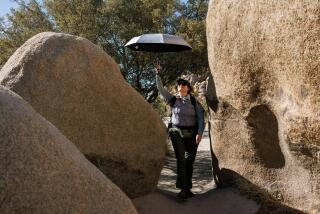Parks Accessible to Disabled Urged : Travel: Authors produce guide book that details openness and limitations at national recreation facilities.
- Share via
SAN FRANCISCO — If you pave it, they will come.
Or so say Wendy Roth and Michael Tompane in their national parks guide for people with disabilities.
Roth, who uses a wheelchair, and Tompane, an avid hiker, went to 45 national parks and visited more than 100 camp sites to test accessibility.
“It’s really about getting people out there and feeling free,” said Roth, 39, whose severe multiple sclerosis was diagnosed about 10 years ago.
The couple’s coast-to-coast travel showed that some parks were naturally accessible. At others, Roth said, officials told her that improvements were unnecessary because disabled people do not use the park.
To that, Roth quotes from the recent movie “Field of Dreams”: “If you build it, they will come.”
“We’re not interested in paving the wilderness,” said Tompane, 40. “But in the cases where the terrain is suitable for full accessibility, we’d like to see improvements made.”
“Easy Access to National Parks: The Sierra Club Guide for People With Disabilities,” (Sierra Club Books, $16) details 15 national parks that the pair deemed “Great Parks.” Access highlights and other basic visitor information are provided for all 45 sites.
The authors said 57% of people in the United States cannot walk a simple forest trail because of age, a permanent disability or temporary injury.
Roth and Tompane praised Yellowstone National Park for its wheelchair-accessible trails; Rocky Mountain National Park for its Handicamp, a campground for the disabled; and Redwood National Park in California for its trails marked in Braille.
Everglades National Park in Florida won kudos for its paved trails and canoe trips for the disabled, including people with wheelchairs. Mother Nature got part of the credit because of the park’s flat terrain.
But other national parks had little or no access for the handicapped, forcing visitors to revert to what the book calls windshield experiences--viewing a park from inside a car.
In 1990, Roth found herself viewing the south rim of the Grand Canyon from the Hopi Point parking lot.
“It was pretty frustrating and surprising. I always wanted to see the Grand Canyon. And I did see it, but I didn’t want to see it from a parking lot,” Roth said.
A ramp was added at Hopi Point a year later, but many other scenic points and toilet, shower and camping facilities at the canyon remain inaccessible.
Roth and Tompane listed the Great Smoky Mountains as the worst national park for the disabled. Among problems cited in the book:
* Clingmans Dome: A famous mountain view is a steep half-mile walk to an elevation of 6,643 feet. Though the road is paved, wheelchairs or people with other mobility problems may need assistance.
* Roaring Fork Motor Nature Tour: Slopes to the turnouts on this self-guided car tour through the forest are steep and unsuitable for wheelchairs.
* Cades Cove: Many of the old homes belonging to former pioneers have steps to the entrances and are not equipped with ramps.
The authors say they want to inform the disabled and spur change, not scold the Park Service.
“It’s not about people being disregardful or disrespectful,” Roth said. “It’s just time to start making changes.”
They said their findings helped persuade the Park Service and the National Park Foundation, which raises money for the service, to begin a national campaign to improve its parks.
Six parks are slated to finish improvements by next year and nine have already upgraded facilities for people with limited mobility.
More to Read
Sign up for The Wild
We’ll help you find the best places to hike, bike and run, as well as the perfect silent spots for meditation and yoga.
You may occasionally receive promotional content from the Los Angeles Times.






